Rostov
Ростов | |
|---|---|
 Spasso-Yakovlevsky Monastery | |
.png.webp) Flag .png.webp) Coat of arms | |
Location of Rostov | |
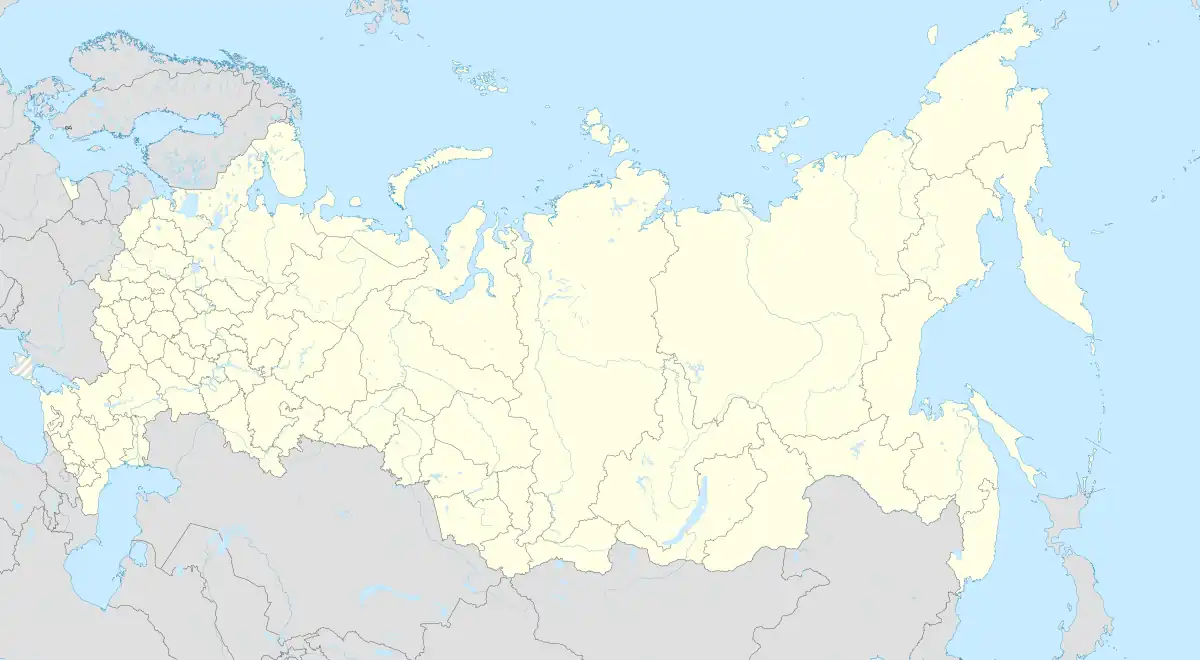 Rostov Location of Rostov 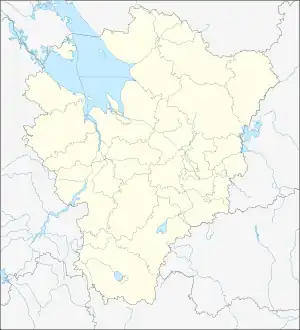 Rostov Rostov (Yaroslavl Oblast) | |
| Coordinates: 57°11′N 39°25′E / 57.183°N 39.417°E | |
| Country | Russia |
| Federal subject | Yaroslavl Oblast[1] |
| Founded | 862 |
| Government | |
| • Mayor | Andrey Los'[2] |
| Elevation | 100 m (300 ft) |
| Population | |
| • Total | 31,792 |
| • Estimate (2018)[4] | 30,969 (−2.6%) |
| • Subordinated to | town of oblast significance of Rostov[1] |
| • Capital of | Rostovsky District,[1] town of oblast significance of Rostov[1] |
| • Municipal district | Rostovsky Municipal District[5] |
| • Urban settlement | Rostov Urban Settlement[5] |
| • Capital of | Rostovsky Municipal District, Rostov Urban Settlement[5] |
| Time zone | UTC+3 (MSK |
| Postal code(s)[7] | 152150 |
| Dialing code(s) | +7 48536 |
| OKTMO ID | 78637101001 |
Rostov (Russian: Росто́в, IPA: [rɐˈstof]) is a town in Yaroslavl Oblast, Russia, one of the oldest in the country and a tourist center of the Golden Ring. It is located on the shores of Lake Nero, 202 kilometers (126 mi) northeast of Moscow. Population: 30,406 (2021 Census);[8] 31,792 (2010 Census);[3] 34,141 (2002 Census);[9] 35,707 (1989 Census).[10]
While the official name of the town is Rostov, it is popularly known to Russians as Rostov Veliky (Russian: Ростов Великий, Rostov the Great) to distinguish it from the much larger city of Rostov-on-Don. The name of the town railway station is Rostov Yaroslavsky, due to its location in Yaroslavl Oblast.
History
Rostov was preceded by Sarskoye Gorodishche, which some scholars interpret as the capital of the Finnic Merya tribe, while others believe it was an important Viking trade enclave and fortress guarding the Volga trade route. It is known from Norse sources as Raðstofa. Scythians also settled there. These different ethnicities, such as the Vikings, Scyths, Slavs and Finns, were likely the ancestors of many of today's people in that region. First mentioned in documents in the year 862 as an already important settlement, by the 10th century Rostov became the capital city of Vladimir-Suzdal, one of the most prominent principalities in Rus'. It was incorporated into the Grand Duchy of Moscow in 1474.[11]
After losing its independent status, Rostov was still an ecclesiastic center – from 988 it was the see of the Diocese of Yaroslavl, one of the first Russian bishoprics. In the 14th century, the bishops of Rostov became archbishops, and late in the 16th century, metropolitans. One of those metropolitans, Iona (Jonah) Sysoyevich (c. 1607–1690), commissioned the town's main landmark: the Rostov Kremlin. This is regarded by some as the finest outside that of Moscow.[11] the Poles in 1608, Rostov survived as a medium-sized town. Late in the 18th century, the metropolitan see was transferred to Yaroslavl.
Rostov is renowned for manufacturing enamels.
On August 24, 1953, the town was hit by an F3 tornado, causing severe damage. The tornado traveled 6 kilometers with a maximum width of up to 550 meters.[12]
Administrative and municipal status
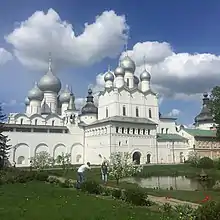
Within the framework of administrative divisions, Rostov serves as the administrative center of Rostovsky District, even though it is not a part of it.[1] As an administrative division, it is incorporated separately as the town of oblast significance of Rostov—an administrative unit with the status equal to that of the districts.[1] As a municipal division, the town of oblast significance of Rostov is incorporated within Rostovsky Municipal District as Rostov Urban Settlement.[5]
Main sights
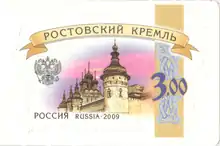
The architecture of the city shows many examples of early Russian Orthodox architecture. The central town square of Rostov is occupied by the Assumption Cathedral. It is unknown when the present building was erected, the mid-16th century being the most likely date. Lower parts of the cathedral walls are dated to the 12th century. The ponderous bell tower was constructed mostly in the 17th century. Its bells are among the largest and most famous in Russia - each has its own name. The largest bell, cast in 1688, weighs 32,000 kilograms (71,000 lb). It is named Sysoy to honor the city's founding father. The church is home to the incorrupt body of Saint Leontius of Rostov.[13]
An area situated between the cathedral square and the lake was chosen by Iona Sysoevich as a place for his fairy-tale residence. All the construction works were carried out between 1667 and 1694. Major buildings include the ornate Savior Church-na-Senyakh (1675), the sombre Church of St. Gregory (1670), and the barbican churches of St. John the Apostle (1683) and of the Resurrection of Christ (1670). The residence, often erroneously called kremlin, also includes eleven ornate tower bells, numerous palaces, several small belfries, and the diminutive baroque Church of Our Lady of Smolensk (1693). All the churches are elaborately painted and decorated.
The cathedral and four tall kremlin churches with their silver "blind" domes were imitated throughout the city. This is particularly evident in the Savior-on-the-Market church and the cathedral church of the Nativity convent, both dating from the 17th century and situated near the kremlin walls. The oldest church within the town center was consecrated to St. Isidore the Blessed in 1565. They say that Ivan the Terrible had the architect executed, because his church was so much smaller than its predecessor.
The kremlin is flanked by two monasteries, both facing the Lake Nero. To the right from the kremlin stands the Abraham monastery, founded in the 11th century and one of the oldest in Russia. Its cathedral, commissioned by Ivan the Terrible in 1553 to commemorate the conquest of Kazan, inspired numerous churches in the region, particularly in Yaroslavl.
Spaso-Yakovlevsky Monastery, situated to the left from the Kremlin on the town's outskirts, has been venerated as the shrine of St. Dmitry of Rostov. Most of the monastery structures were built in the late 18th and early 19th centuries in the fine neoclassical style. There are also two 17th-century churches: the Conception of St. Anna, and the Transfiguration of Our Savior. Unlike most other churches in the town, the monastery belongs to the Russian Orthodoxy and houses a theological seminary.
 Cathedral of the Dormition of the Theotokos
Cathedral of the Dormition of the Theotokos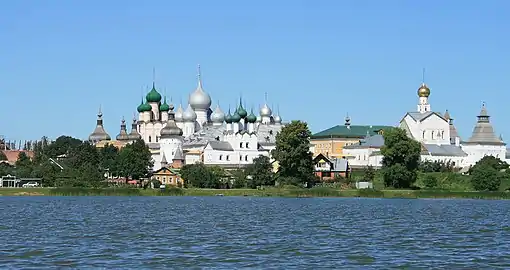 The citadel of Rostov seen from Lake Nero
The citadel of Rostov seen from Lake Nero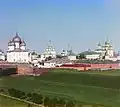 Rostov Kremlin in summer (1911)
Rostov Kremlin in summer (1911)_(8).JPG.webp) The courtyard in the kremlin
The courtyard in the kremlin Lake Nero
Lake Nero
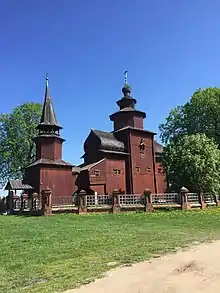
Surroundings
The vicinity of Rostov is rich in old architecture. For example, an old wooden church (1687–1689) may be seen in Ishnya. One of the best preserved monasteries in Russia, named after the saints Boris and Gleb, is situated in Borisoglebsky, about 20 kilometers (12 mi) west of the town. The monastery was favored by Ivan the Terrible, who personally supervised the construction of towered walls and bell-tower around an even more ancient cathedral. The only addition made to the monastery after Ivan's death is a barbican church, commissioned by the metropolitan Iona Sysoyevich.
Twin towns/sister cities
Rostov in films
- Peter I (Russian: Пётр Первый) (1937), by Vladimir Petov
- Ivan Vasilievich: Back to the Future (Russian: Иван Васильевич меняет профессию, Ivan Vasilievich Changes His Profession) (1973), by Leonid Gaidai
Notable people
- Dmitry Borisovich (1253–1294), Russian nobleman
- Konstantin of Rostov (1186–1218), the eldest son of Vsevolod the Big Nest and Maria Shvarnovna
- Vasilko Konstantinovich (1209–1238), the first Prince of Rostov
- Olena Kryvytska (born 1987), Ukrainian fencer
- Lev Naumov (1925–2005), Russian classical pianist, composer and educator
- Yuri Alexandrovich Bilibin (1901–1952), geologist
- Vera Dmitrievna Titova (1888–?), Russian scientist and educator[16]
- Aleksandr Safoshkin (1976-) Russian gymnast
References
Notes
- 1 2 3 4 5 6 7 Law #12-z
- ↑ Биография. Сайт администрации города Ростова Великого (in Russian). Archived from the original on February 24, 2020. Retrieved February 24, 2020.
- 1 2 Russian Federal State Statistics Service (2011). Всероссийская перепись населения 2010 года. Том 1 [2010 All-Russian Population Census, vol. 1]. Всероссийская перепись населения 2010 года [2010 All-Russia Population Census] (in Russian). Federal State Statistics Service.
- ↑ "26. Численность постоянного населения Российской Федерации по муниципальным образованиям на 1 января 2018 года". Federal State Statistics Service. Retrieved January 23, 2019.
- 1 2 3 4 Law #65-z
- ↑ "Об исчислении времени". Официальный интернет-портал правовой информации (in Russian). June 3, 2011. Retrieved January 19, 2019.
- ↑ Почта России. Информационно-вычислительный центр ОАСУ РПО. (Russian Post). Поиск объектов почтовой связи (Postal Objects Search) (in Russian)
- ↑ Russian Federal State Statistics Service. Всероссийская перепись населения 2020 года. Том 1 [2020 All-Russian Population Census, vol. 1] (XLS) (in Russian). Federal State Statistics Service.
- ↑ Russian Federal State Statistics Service (May 21, 2004). Численность населения России, субъектов Российской Федерации в составе федеральных округов, районов, городских поселений, сельских населённых пунктов – районных центров и сельских населённых пунктов с населением 3 тысячи и более человек [Population of Russia, Its Federal Districts, Federal Subjects, Districts, Urban Localities, Rural Localities—Administrative Centers, and Rural Localities with Population of Over 3,000] (XLS). Всероссийская перепись населения 2002 года [All-Russia Population Census of 2002] (in Russian).
- ↑ Всесоюзная перепись населения 1989 г. Численность наличного населения союзных и автономных республик, автономных областей и округов, краёв, областей, районов, городских поселений и сёл-райцентров [All Union Population Census of 1989: Present Population of Union and Autonomous Republics, Autonomous Oblasts and Okrugs, Krais, Oblasts, Districts, Urban Settlements, and Villages Serving as District Administrative Centers]. Всесоюзная перепись населения 1989 года [All-Union Population Census of 1989] (in Russian). Институт демографии Национального исследовательского университета: Высшая школа экономики [Institute of Demography at the National Research University: Higher School of Economics]. 1989 – via Demoscope Weekly.
- 1 2 Brumfield, W. (September 6, 2019). "The Cathedral of Rostov the Great: Reclaiming Russia's past". Russia Beyond the Headlines. Retrieved January 29, 2020.
- ↑ "European Severe Weather Database". Archived from the original on April 30, 2022.
- ↑ Internetowa Liturgia Godzin
- ↑ "Ystävyyskaupungit" (in Finnish). Suomalais-venäläinen kauppakamari. Archived from the original on September 19, 2012. Retrieved May 7, 2012.
- ↑ "Interactive City Directory". Archived from the original on March 4, 2016. Retrieved July 10, 2015.
- ↑ "Interview: A 19th-century Woman of Science". Retrieved October 11, 2022.
Sources
- Государственная Дума Ярославской области. Закон №12-з от 7 февраля 2002 г «Об административно-территориальном устройстве Ярославской области и порядке его изменения», в ред. Закона №67-з от 21 декабря 2012 г. «О внесении изменений в отдельные законодательные акты Ярославской области и признании утратившими силу отдельных законодательных актов (положений законодательных актов) Ярославской области». Вступил в силу через шесть месяцев со дня официального опубликования. Опубликован: "Губернские вести", №11, 15 февраля 2002 г. (State Duma of Yaroslavl Oblast. Law #12-z of February 7, 2002 On the Administrative-Territorial Structure of Yaroslavl Oblast and on the Procedures of Its Change, as amended by the Law #67-z of December 21, 2012 On Amending Various Legislative Acts of Yaroslavl Oblast and on Abrogation of Various Legislative Acts (Clauses of Legislative Acts) of Yaroslavl Oblast. Effective as of the day six months from the day of the official publication.).
- Государственная Дума Ярославской области. Закон №65-з от 21 декабря 2004 г. «О наименованиях, границах и статусе муниципальных образований Ярославской области», в ред. Закона №59-з от 28 декабря 2011 г «Об изменении статуса рабочего посёлка Песочное Рыбинского района и о внесении изменений в отдельные законодательные акты Ярославской области». Вступил в силу через 10 дней со дня официального опубликования. Опубликован: "Губернские вести", №70, 23 декабря 2004 г. (State Duma of Yaroslavl Oblast. Law #65-z of December 21, 2004 On the Names, Borders, and Status of the Municipal Formations of Yaroslavl Oblast, as amended by the Law #59-z of December 28, 2011 On Changing the Status of the Work Settlement of Pesochnoye of Rybinsky District and on Amending Various Legislative Acts of Yaroslavl Oblast. Effective as of after 10 days from the day of the official publication.).
Further reading
External links
- Website of Rostov Kremlin
- Landmarks of Rostov (Archived December 5, 2004, at the Wayback Machine) (in Russian)
- More landmarks of Rostov (Archived December 5, 2004, at the Wayback Machine) (in Russian)
- The Monastery of Sts Boris and Gleb (Archived October 31, 2004, at the Wayback Machine) (in Russian)
- Interior view of the Rostov Kremlin
- Moonlight view of the Yakovlevsky Monastery from the Lake Nero
- The orthodox newspaper of Rostov Veliky (in Russian)
- Rostov the Great Archived July 12, 2012, at the Wayback Machine